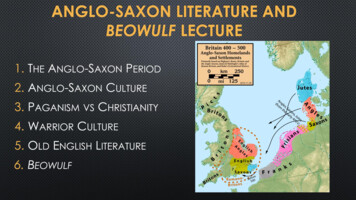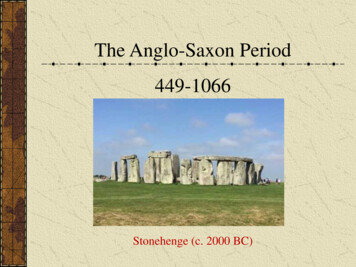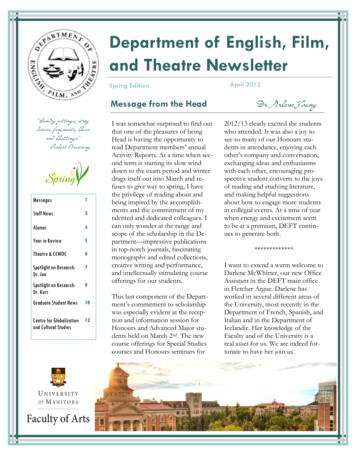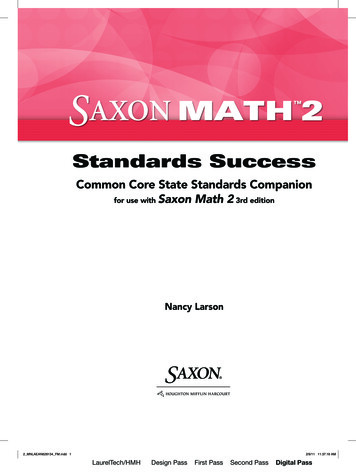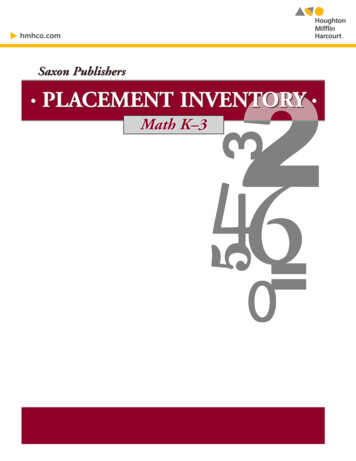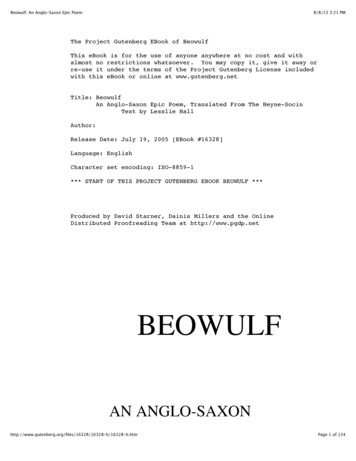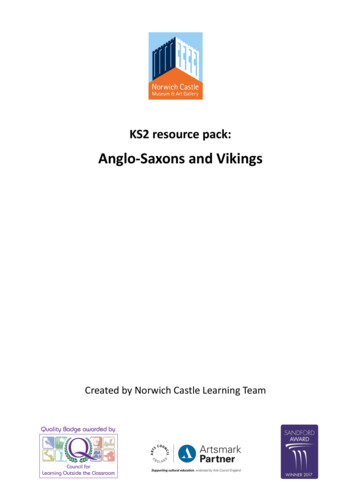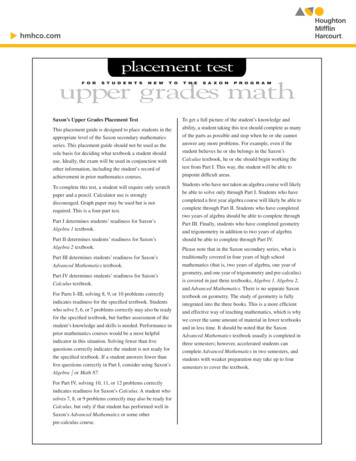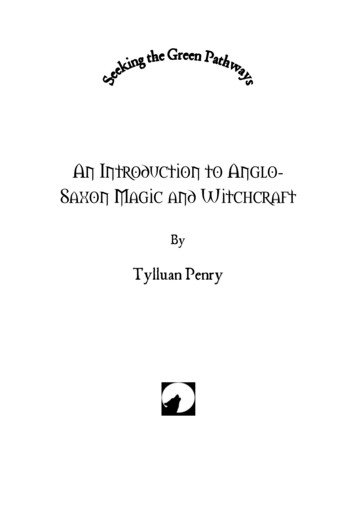
Transcription
An Introduction to AngloSaxon Magic and WitchcraftByTylluan Penry
Copyright 2014 Tylluan PenryISBN 978-0-9931460-1-5ALL RIGHTS RESERVEDTylluan Penry has asserted her right under the Copyright Designsand Patents Act of 1988 to be identified as the author of this work.No part of this publication may be reproduced, stored in a retrievalsystem or transmitted in any form or by any means, electronic,mechanical, photocopying, scanning, recording or otherwise withoutthe prior written permission of the author and the publisher.Cover photo by Shutterstock, cover design by J. MaggsPublished by: The Wolfenhowle Press, Redcroft, Nile Road, TrealawTonypandy, CF40 2UYhttp://thewolfenhowlepress.comPrinted by: Book Printing UK, Remus House, Coltsfoot Drive,Woodston, Peterborough, PE2Other books by Tylluan Penry:A Little Book of Inspirations (2014); Knot Magic (2014); MagicalNature Walks (2014); Sacred Shadows (2013); The Magical World ofthe Anglo-Saxons (2012); Staying on the Old Track (2012); Magic onthe Breath (2011); The Essential Guide to Psychic Self Defence (2010);The Magical Properties of Plants (2009); Seeking the Green (2008)
An introduction toAnglo-Saxon Magic and WitchcraftIt is not easy to discover exactly what the Anglo-Saxons thought aboutmagic and witchcraft before the coming of the Christian missionariesespecially in a small booklet such as this, nor how it was practised. Mypurpose is to clarify some of the more confusing aspects in order tomake it easier for the Reader to pursue further studies in the subject.England had been Christian for some time before the boatloads ofAngles, Jutes, Saxons and others arrived in the early fifth century. Latermissionaries sent from the Continent claimed the conversion wascomplete by the mid seventh century. Strictly speaking, heathen AngloSaxon England covered a period of barely two and a half centuries.It might seem therefore that we are looking for a tiny needle in a verycrowded haystack, made all the more difficult because the heathenAnglo-Saxons never wrote anything down and the songs and storiesthey memorised and recited in the mead halls have not survived.However, there is information if we know where to look. Often it ishidden in the work of authors such as Bede, the Northumbrian monkwhose works, especially The Ecclesiastical History of the English Nation(EHEN) and De Temporum Ratione tell us something of the beliefs andpractices of the Anglo-Saxons, both before, during and after theyconverted to Christianity.There is even evidence to be found in the dictionary. For example, weknow the Anglo-Saxons recognised the existence of Witchcraft andMagic because they had so many words and phrases covering a widerange of magical practices. From lybcræft meaning magic, lybblácmeaning witchcraft, begalan meaning to enchant (often by means ofsung charms) to the dreaded morþ weorc, which meant using poison orwitchcraft (and sometimes both) to kill someone, the language was richand full with magical meaning. They must – at least during theChristian period – have feared dēofol-cræaft, and the word dry meant a1
magician, therefore dry-cræft meant magical work. This suggests thatmagic and witchcraft were not exactly the same as each other.We also know that magical practices were hard to eradicate since manyChristian kings passed laws against it, something they would surely nothave had to do had people completely turned their backs on their oldpractices and traditions once they were baptised. Although on thesurface beliefs had changed, many seem to have clung doggedly to theirold rituals, celebrations and practices.Some of these edicts against magic were surprisingly late, and showhow persistent these old ways must have been. For example, in theearly eleventh century, King Cnut passed a law forbidding ‘. allheathen practices. Namely the worship of idols, heathen gods, and thesun or the moon, fire or water, springs or stones or any kind of foresttrees, or indulgence in wiccecraæft or morþweorc, that is the compassing ofdeath in any way, either by sacrifice or by divination.’Of course it would be wrong to assume that most English people weredoing all these things in the early eleventh century. Some may havebeen, but sometimes kings needed to be seen to ‘do something’, makingthese clauses more or less obligatory, i.e. the sort of thing that wasincluded whether or not they were actually needed. Unfortunately, wedo not know how far this was true in eleventh century England.However we do know the Anglo-Saxons must have placed great faith invarious portents, since a number of them have survived. For example,‘To receive a ring in dreams betokens freedom from care. to acceptnew cheese betokens gain’ (Cockayne 1961 iii, 200ff). We also knowthat many people believed in ghosts due to the number of words thatmean phantoms, from the shining spectre scin, to the more frighteningeges-grima meaning a horrible spectre.Up until about 1950, many people still believed that the heathen AngloSaxon centuries really were barbaric. I remember one of my oldteachers saying it was called the Dark Ages because the light ofChristianity went out and everything was utterly ruined when theRomans left! Yet one look at their glorious metal-work and jewellery2
shows that whatever else they may have been, the heathen AngloSaxons were skilled and civilised. Unfortunately they were a nonliterate society which had implications for how they were portrayed bythe later, literate clerics and clergy.Although all the surviving Anglo-Saxon literature was transcribed afterEngland became Christian, much of it had been composed orally thenmemorised and passed down by word of mouth for centuries. Ofcourse, by the time the Christian scribes (almost all clergy) wroteeverything down, they were in a position to erase most of the obviouslyheathen references – if they could find them. This may sound a littlestrange, but the Anglo-Saxons were very keen on jokes, riddles andverbal games which we find they incorporated into much of thesurviving literature. Hiding heathen references would have been child’splay for bards and poets with such an agile sense of fun!It is important therefore not to allow ourselves to be too easilypersuaded that evidence regarding the heathen Anglo-Saxons has gonefor good. It has not. Even sober, impeccably Christian authors such asBede (writing in the eighth century) can unwittingly tell us a great dealonce we know how to look.For example, when Pope Gregory I sent Augustine (later known asSaint Augustine of Canterbury) to convert the English, herecommended incorporating as much of the old heathen beliefs aspossible (EHEN I, 30). In particular he advised Augustine to take overheathen feast days but turn them into Christian celebrations, and evento acquire heathen temples and altars, consecrating them instead to theChristian God. Everything heathen should as far as possible, the popesaid, be retained but overlaid with Christian symbolism and meaning.We refer to this process as Christianisation. Of course, some heathentraditions proved resistant, and when this happened we see an abruptchange in Church policy. The old beliefs and practices were thendenounced as being in league with the devil. This is calleddemonization and is easy to spot once we know what to look for.Bede occasionally gives us a glimpse of the heathen point of view, too.For example, when Augustine and his fellow missionaries landed in3
England in 597 CE, King Æthelbert insisted on meeting them in theopen, in case they tried to enchant him (EHEN I, 25). This is a curiousstatement, suggesting he believed that magic was somehow moredangerous or more likely to occur indoors and has some interestingimplications when we look at elves later on.Although we do not know exactly what magical mysteries themissionaries encountered when they arrived in England, the AngloSaxon language is rich with words associated with what we would nowtranslate as witchcraft or magic. However we must remember that themeanings we attach to such words are not necessarily the same as themeanings given to them fourteen hundred years ago.For example, nowadays the word Wicca is given to a very specificpagan path, founded (or rediscovered, depending on one’s point ofview) by Gerald Gardner in the late 1940’s – early 1950’s. Yet wicca(with no capital letter) was a name given to male magicians, sorcerersand wizards, while wicce meant a female witch or sorceress. Bothchanged to wiccan in the plural form, whereas nowadays, to be Wiccanmeans to follow the path of Wicca. Modern Wicca is regarded as areligious path, but we have no way of knowing how the heathen AngloSaxons regarded their wiccan.Words that show people who specialised in magic tell us that this musthave been a well established practice. Wiccian meant to practice witchcraft, while wiccecræft and wiccedóm both meant magic or witchcraft. Ofcourse, whether we view magic as a good or bad thing depends verymuch on how it is used. To have great power and use it for good is awonderful thing, whereas to use it to harm others tends to frighten theliving daylights out of us. This does not only apply to magic, of course.Much the same can be said of people who drive an ambulance quicklybut safely to the local hospital in an emergency, compared to themaniac who drives a Ferrari at 100mph in a built up area!IF YOU HAVE ENJOYED THIS BOOK SO FAR, PLEASECONSIDER BUYING A COPY!4
changed to wiccan in the plural form, whereas nowadays, to be Wiccan means to follow the path of Wicca. Modern Wicca is regarded as a religious path, but we have no way of knowing how the heathen Anglo-Saxons regarded their wiccan. Words that show people who specialised in magic tell us that this must have been a well established practice.
